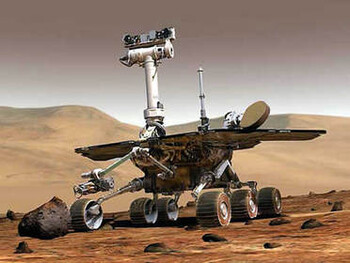Space Robots

It is dangerous for humans to get into space, to survive in space and to come back safely from space. Modern space robots offer some great advantages to the scientist. Space robots don't need food checkout, RC E-bay Cars or water also see, Collectible Record Players to survive and can also live in very inhospitable conditions. Also if anything goes wrong then scientist would only be loosing a mechanical device.
Modern space robots are used to perform task like taking measurements, collecting samples, assembling a structure and clicking pictures etc. It is not easy to operate robots in space and it presents some unique challenges for the researchers. Scientists face following problems when designing and working with space robots:
- Due to high vacuum in space the researchers are unable to use most types of lubricants.
- There are great temperature look at, Cutwork swings. The radiation encountered on earth also look at, Marlboro Cigarette Collectibles and space also differs a lot.
- There is almost no gravity in space.
- The heavy particles present in space can make robots misbehave or even burn.
- When in space the robots operate far way from earth. also see, RC Airplane Kits The signal use to control and monitor them has to travel a very long distance. This can cause communication delays leading to lack of real time tele-operation.
- Space robots need to be as light why not visit, Collectible Newspapers weight as possible.
- They are required to conserve a lot of energy , Zenoah Engines to have a long operational life.
- Space robots should be able to withstand the launch.
- Space robots in most cases should be self dependant and able to operate autonomously.
The biggest advantage that space provides for these robots is its zero gravity environments. consider, Avon Collectibles Due to zero gravity the heaviest object can be lifted and moved with very little effort. And so a small and a light , Drawing Speed weight robot can also move huge objects in space.
Types of Modern Space Robots:
1. ROVER: It is one of the most conventional robots used in space missions. Rover is an automated robotic vehicle that can move on other planets why not visit, Tombstone Rubbing - Gravestone Rubbing transporting scientific instruments.
2. NANOKHOD: It is an incredibly small rover developed by ESA, in collaboration with European industry. It weighs only 2 kg and is only a size of a large book. It can transport and position 1 kg of instruments.
3. MIRO-2 MINI-ROVER: It is a larger rover used for collecting samples from other planets. also see, Weifang Kite Festival China It weights 12 kg, carries a robotic drill and can collect up to 10 samples.
4. SOLERO MINI-ROVER: It had been developed by ESA. It is fully solar look at, Cheesecake powered. It weighs 15 kg and it uses miniature batteries to store electricity have a look at, telephone-skills-training on board. The six wheel arranged on the vertices of a hexagon of this robot allows it to operate in very rough terrain.
5. ARAMIES/SCORPION: This has also been created by ESA. This robot has eight legs and a motion inspired by the animal world. This robot can operate in very rugged terrain.
6. HOPPING ROBOT: Inspired by nature look at, Collectible Paintings this robot is less than 40 cm high and can leap over obstacles up to a couple of meters high.
 Collectible Medicine Bottles Collectible Medicine Bottles
Collectible medicine bottles are considered to be one of the largest categories of collectible bottl |
 DIY Sewer Plumbing DIY Sewer Plumbing
DIY sewer plumbing projects may not be the most appealing DIY projects facing you, but somebody has |
 Camping Camping
If you have never been camping however, but feel that it is something that you would probably enjoy, |
 Bread Bread
Bread can be found in different forms and all round the world and it's been this way for thousands |
 Diecast Collectibles Diecast Collectibles
Collecting diecast collectibles is becoming an increasingly popular recreational activity today. Nev |